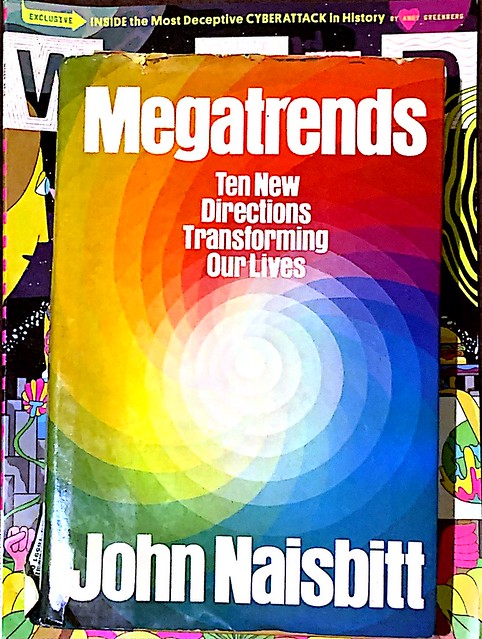3 minutes estimated reading time
John Naisbitt’s Megatrends was on the New York Times bestseller list when it was first published in 1982. Naisbitt outlined some big long term trends that he’d found as part of a decade of research. Hence the mega in Megatrends; though one could argue that macro may have been a more accurate term to use.
I wasn’t that familiar with the work of Naisbitt; but came upon it by a circuitous route.
My circuitous route to Megatrends
I was introduced to the works of futurist Alvin Toffler in college reading Future Shock, The Third Wave and Power Shift. At the time these were cited on the technology degree courses my friends were on; as well as the marketing course I was studying.
My house mate and I would talk about Toffler’s books as much Robert Pirsig or Emmanuel Kant, on the sofa of an evening sipping really bad instant coffee. I wouldn’t say that those were particularly happy days for me, but they did give me the time to think and read. Something that is much more of a struggle now.
As I became more interested in Asia in the late 1990s; l read about how Toffler had influenced technocratic leaders from Singapore to China. I also started to read about John Naisbitt. Like Toffler, Naisbitt had done the Asian speaker circuits, met senior officials and conducted projects in-country through the 1990s. The management consultancy Toffler Associates eventually operated in China on government and private sector briefs.
Compared to Toffler; Naisbitt seems to have become much more personally committed to China and central Europe. He has alternately lived in Vienna and in Tianjin, China. As the dot com boom kicked off I was reading this book. It fitted right in with similar writings from publications like Gilder Technology Report, Wired and Upside.
Back to the Megatrends review
In Megatrends Naisbitt sets out X large scale long term trends that he sees in society
- Information society and the rise of the knowledge worker
- High tech / high touch – Naisbitt saw that roles would focus more on technology, or on ‘high touch’ sectors where humans aren’t easily replaceable like nursing care
- Globalisation – a move in focus from the national economy to the world economy as the world becomes more interconnected
- A move in strategic focus from short-term planning to long term planning.
- Decentralisation of power and structures
- A move from institutional help to self-help
- Bottom-up governance across government and other organisations as a channel for public opinion
- The move from hierarchies to networks
- The population shift in the US from north to south
- Increase in consumer choice
At the top line we can still see much of these changes. I can see how Naisbitt’s vision of globalisation would appeal to the likes of Singapore and China. I am less sure about how Chinese technocrats would have made of bottom up decision making or as Naisbitt puts it ‘participatory democracy’.
Naisbitt failed to take the next logical step; to look at the interactions between the trends. Instead the chapters remained siloed, rather than in context.
For instance that the decline of hierarchies and rise of knowledge workers saw layers of management shed by organisations. Or the link between consumer choice and the rise of globalisation.
Conclusion
Megatrends has value in the way that looks at trends without looking at the how (usually mentioning digitalisation or some similar vehicle of transformation). This is something that we probably wouldn’t be able to do now; given that our mindset is about big data and agile processes. More book reviews here.
